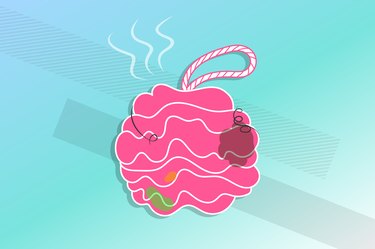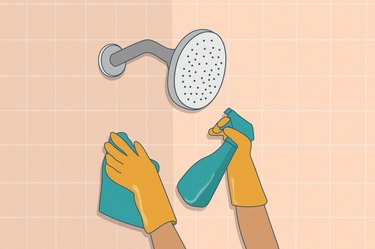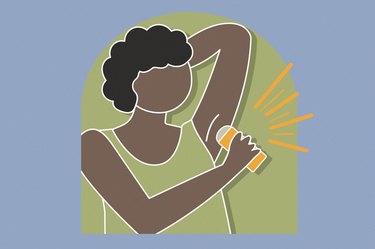
Loofah lovers, it's time to get real. It's about your sudsing-up habits.
If you're someone who bought a loofah years ago and the pouf is still performing, skin experts suggest you swap it out. In fact, you should probably ditch the loofah entirely. (If you're a die-hard, this is probably hard to hear. Apologies.)
Video of the Day
Video of the Day
A loofah is also called a bath pouf, and it's made of nylon mesh. Other natural versions are made with plant fibers. They're beloved because you simply squirt in some shower gel and squish to create loads of lather, which you then spread on your skin. When you've finished cleansing, rinse off the loofah, hang it up in the shower and you're done.
It all sounds good, but the perky pouf has a dark side. Here's what can happen if you use a loofah for too long.
It Can Cause Skin Issues
"In general, I'm not a fan of loofahs," Mona A. Gohara, MD, associate clinical professor of dermatology at Yale School of Medicine, tells LIVESTRONG.com. "I find them to be too harsh on the skin and a compromise to the skin barrier."
That applies to natural loofahs, too, board-certified dermatologist Lauren Eckert Ploch, MD, tells LIVESTRONG.com. "Natural loofas — those made of a gourd — are too abrasive for the skin," she says. When that type of trauma happens, it can cause skin to thicken.
It Could Lead to Infection
Synthetic versions made of nylon are apt to grow mold and fungus if you use the same one "forever," Dr. Ploch says. Here's why that's bad (beyond the ick factor): "Washing, especially scrubbing the skin with an infected loofah could potentially lead to skin infections," she says.
Other bacteria, such as staphylococcus, which can naturally live on your skin, can also cause skin infection, notes the Cleveland Clinic. If there is fungus present on your skin, such as athlete's foot or tinea versicolor, you could continually reinfect yourself or spread it to other body parts with a loofah.
There is a case report of a bacteria-laden loofah exacerbating skin disease. Turns out, the loofah spread Streptococcus bacteria that had caused impetigo (a bacterial infection that causes sores) and cellulitis (another bacterial infection that appears as redness and sores) further around the body, causing secondary infection, according to a January 2022 report in IDCases.
The authors of that report discovered that the loofah was acting as a reservoir for this bacteria. As they point out, loofahs can cause microtrauma to the skin, which then gives bacteria a place to waltz right in and cause infection.
Past research also points out that loofahs exfoliate and trap dead skin cells in their fibers, which may also promote bacterial growth. And an even older report from the same authors dubbed loofahs a "potential health problem."
What to Use Instead of a Loofah
Better to use a washcloth or your hands when sudsing up, Dr. Gohara says. Both alternatives are "more gentle and less harsh to the skin barrier."
Dr. Ploch recommends washing your body using your hands and then using a washcloth to clean your butt, groin and armpits. A washcloth is not only softer on skin, but it can easily be washed in your machine, making for a cleaner cleanser.
How to Use a Loofah Safely
If you are sticking with the loofah, that's totally your choice. Maybe you've used them and haven't experienced any skin problems as a result. Still, here are some best practices to follow, courtesy of Dr. Gohara:
- Make sure you allow the loofah to completely dry in between uses.
- Absolutely do not share a loofah with friends or family.
- Change out your loofah once a month.
Because you'll be tossing loofahs left and right, Dr. Gohara suggests choosing a biodegradable brand in order to lessen your impact on the environment.
So, How Bad Is It Really to Use the Same Loofah Forever?
Pretty bad. The abrasive material can harm skin, while bacteria and mold can collect within its materials.
Change out your loofah once a month, or switch to using a washcloth or your hands instead, dermatologists recommend.
- Centers for Disease Control and Prevention: “Impetigo: All You Need to Know.”
- Centers for Disease Control and Prevention: “Cellulitis: All You Need to Know.”
- IDCases: “Streptococcus pyogenes secondary impetigo due to loofah sponge use.”
- Cleveland Clinic: “Staph Infection (Staphylococcus Infection)”
- Journal of Clinical Microbiology: “Loofah sponges as reservoirs and vehicles in the transmission of potentially pathogenic bacterial species to human skin.”
- Journal of Clinical Microbiology: “Pseudomonas aeruginosa folliculitis acquired through use of a contaminated loofah sponge: an unrecognized potential public health problem.”
Was this article helpful?
150 Characters Max
0/150
Thank you for sharing!
Thank you for your feedback!
Is this an emergency? If you are experiencing serious medical symptoms, please see the National Library of Medicine’s list of signs you need emergency medical attention or call 911.



